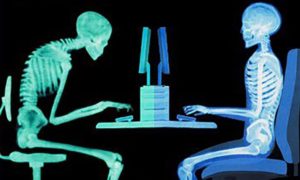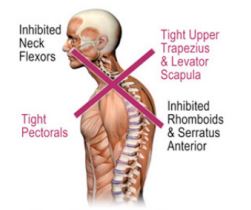Upper Crossed Syndrome
By: Derek Vinge

I am sure everyone has seen someone with Upper Crossed Syndrome (UCS), whether they knew what it was called or not. A person with UCS will look like they are hunched over with rounded shoulders and head protruding forward. The image here shows Mr. Bones on the left has UCS.
Basically, if someone has UCS they will have tight (overactive) upper traps and levator scapula muscles as well as tight chest muscles. Along with these tight muscles, the neck flexors on the front side and the rhomboids and lower traps on the back are weak. The tight or overactive muscles have become shortened and the weak or under active muscles have been lengthened. This is what happens when there is a muscle imbalance in the body.

As you can see in this image, the muscle on the left is the tight (overactive) muscle and the one on the right is the weak (under-active) muscle. UCS is one of the more common muscle imbalances that people posses and the majority of them don’t know they have it. Someone can get UCS from doing repetitive things such as their job. People who sit in a chair all day tend to hunch over and overtime will start to develop UCS. If your job requires you to stand all day while slightly bending over while working with your hands, the same would apply. Also, people that exercise and work out the chest/upper traps a lot more than the lower traps/rhomboids will eventually develop UCS. If you already possessed muscle imbalances before you started exercising then it would gradually get worse as you performed the exercises unless corrected.
People with UCS may complain of symptoms such as neck pain, jaw pain, upper thoracic pain and headaches due to the muscle imbalances and altered posture. Over time poor posture can lead to all the above symptoms as well as more long term complications such as osteoarthritis or degenerative joint disease.
So, how do you fix Upper Crossed Syndrome? You need to stretch the tight (overactive) muscles and strengthen the weak (under-active) muscles. The chest muscles and the upper trap need to be stretched. Here are some examples of stretching that can be done:
- Pectoral Stretch: Stand against an object (or wall) and form a 90 degree angle with your arm.Draw your navel inward. Slowly lean forward until a light stretch is felt in the front shoulder and chest area. Hold the stretch for 30 seconds. Switch arms. Perform 1-2 sets twice per day.
- Upper Trap/Scalene Stretch: Stand in place with good posture. Draw your navel inward. Retract and depress your scapula on the side being stretched. Tuck your chin and slowly flex your head to one side, pulling your ear toward the same shoulder. Hold the stretch for 30 seconds. Switch sides. Perform 1-2 sets each side twice daily.
- The Rhomboids/mid-lower Traps also need to be strengthened. Here is an example of a strengthening exercise that can be done: Pick a weight that you can perform 12-20 reps with easily. You can also use resistance bands in place of weights. Stand with feet shoulder width apart and with good body posture. Draw navel inward. Pull weights (or bands) towrd your lower chest area and flex the trap muscles. Make sure to use your back muscles to pull the weights (or band) toward you and not your biceps. Lower your body as if you were squatting or sitting in a chair. As you lower your body let the weights (bands) for forward. This should be done in a smooth motion. Bring your body back up to the starting position as you bring the weights (bands) toward your lower chest. Do 12-20 reps for 1-2 sets once a day. **Be careful not to elevate the shoulders or protrude your head forward while performing this exercise.**
- Lie prone (stomach down) on the floor. Activate the gluteal muscles and pinch shoulder blades together. Lift the chest off the floor with your thumbs pointed up and arms externally rotated. Hold for 1-2 seconds. Slowly return your body to the ground keeping your chin tucked. Repeat 8-12 times, 1-2 times a day.
If you are still having the symptoms of UCS (headache, exhaustion, and muscle soreness) or would like to learn more solutions for this please book in to the clinic for an assessment. Call 250.871.3674 or book online with the link here.
